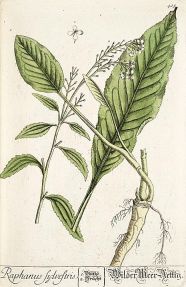A Dash of Horseradish
By Audrey Stallsmith

The first morning I came back from the office I found Katerina Ivanovna had cooked two courses for dinner--soup and salt meat with horse radish--which we had never dreamed of till then.
Crime and Punishment by Fyodor Dostoyevsky
I've recently been eating horseradish on crackers as an afternoon snack. I'd heard it was good for allergies, and mine tend to kick in at this time of year. Since it's a stimulant as well, it also helps keep me from getting drowsy after too many hours at the computer.
As I'm not a fan of "hot" foods, I purchased the cream type which is milder than some. It still does a pretty good job of clearing the sinuses, but doesn't actually make my eyes water. Though I have thus far avoided "holding it in my mouth" as some brave souls recommend! I've found that I actually like the taste of horseradish, and suspect it may become somewhat addictive.
As the quote above suggests, the pungent root probably originated in Eastern Europe and western Asia. Its official names have included Armoracia rusticana, Cochlearia armoracia, and Raphanus rusticana or sylvestris.
Armoracia may derive from the Latin "near the sea" and sylvestris means "in the forest." (Implying that horseradish will grown almost anywhere!) Rusticana means "rustic." Cochlearia means "spoon," in reference to the shape of the leaves, and raphanus just means "radish." The plant has also been known as mountain radish, wild radish, great raifort, red cole, and--for obvious reasons--stingnose.
There isn't much agreement on where the "horse" comes in. Some suggest that it could be a corruption of "harsh" radish. Or the German name meerrettich may have degenerated into "mare's radish" and eventually "horse radish." Still others point out that the word "horse" applied to an herb once meant "coarse." And this plant definitely isn't a delicate one!
As James Duke points out in The Green Pharmacy Herbal Handbook, "Horseradish is pungently persistent in more ways than taste. . .If you ever plant horseradish and then change your mind, you'll have to get rid of every trace of roots." In other words, it is a very tough and invasive plant and can actually reach five feet, though a three-foot height is more typical. In this country, it is most commonly grown in the rich soil of the Mississippi valley--especially in Illinois.
It is generally harvested during the cooler months (those with an "r" in them). Strangely enough the root doesn't develop its characteristic heat until its cells are crushed. At that point it begins "working," whereupon vinegar must be added to "hold" its "hotness."
If it isn't preserved in this manner, it just turns bitter, which may be why it is one of the herbs traditionally consumed at Passover. Often flavored with beet juice, which may be where the "red" in cole comes in.
Although Gerard included it in his herbal--published in the late 1500's, he just mentioned that it was used as a condiment in Germany. It apparently didn't become popular in England until the next century--and then only among the less refined classes. Hence the "rusticana" designation! The Tewkesbury Mustard mentioned by Shakespeare's Falstaff is supposed to be a combination of mustard and horseradish.
Nowadays, of course, British beef wouldn't be complete without horseradish. Not to mention that it has been used to treat almost every ailment imaginable, including whooping cough and other respiratory problems, poor circulation, hoarseness, worms, urinary tract infections, and digestive problems. Externally, it has been applied as a substitute for mustard plasters and to soothe headaches and rheumatism.
Some have even suggested that horseradish will fade freckles. But, if I were going to apply it to my skin, I'd make sure I diluted it quite a bit first! And, although John Heinerman suggests that a rinse made with it will "enliven" the scalp, I'm not sure I want my scalp to be that lively!
All of this healing power James Duke attributes to "pungent sulfur-containing compounds" that "kill germs and stimulate blood flow." Considering all of the plant's uses, the Delphic oracle may have been right that, "The radish is worth its weight in lead, the beet its weight in silver, the horseradish its weight in gold."
Raphanus sylvestris image is from Herbarium Blackwellianum, courtesy of the Missouri Botanical Garden.








